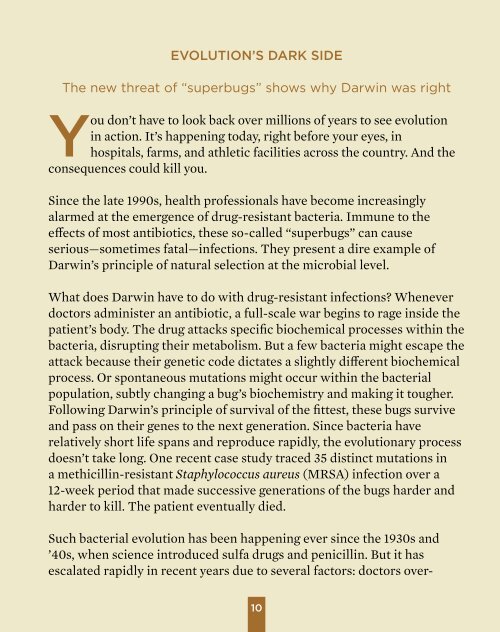CHARLES DARWIN - Athena
CHARLES DARWIN - Athena
CHARLES DARWIN - Athena
- No tags were found...
Create successful ePaper yourself
Turn your PDF publications into a flip-book with our unique Google optimized e-Paper software.
Evolution’s Dark SideThe new threat of “superbugs” shows why Darwin was rightYou don’t have to look back over millions of years to see evolutionin action. It’s happening today, right before your eyes, inhospitals, farms, and athletic facilities across the country. And theconsequences could kill you.Since the late 1990s, health professionals have become increasinglyalarmed at the emergence of drug-resistant bacteria. Immune to theeffects of most antibiotics, these so-called “superbugs” can causeserious—sometimes fatal—infections. They present a dire example ofDarwin’s principle of natural selection at the microbial level.What does Darwin have to do with drug-resistant infections? Wheneverdoctors administer an antibiotic, a full-scale war begins to rage inside thepatient’s body. The drug attacks specific biochemical processes within thebacteria, disrupting their metabolism. But a few bacteria might escape theattack because their genetic code dictates a slightly different biochemicalprocess. Or spontaneous mutations might occur within the bacterialpopulation, subtly changing a bug’s biochemistry and making it tougher.Following Darwin’s principle of survival of the fittest, these bugs surviveand pass on their genes to the next generation. Since bacteria haverelatively short life spans and reproduce rapidly, the evolutionary processdoesn’t take long. One recent case study traced 35 distinct mutations ina methicillin-resistant Staphylococcus aureus (MRSA) infection over a12-week period that made successive generations of the bugs harder andharder to kill. The patient eventually died.Such bacterial evolution has been happening ever since the 1930s and’40s, when science introduced sulfa drugs and penicillin. But it hasescalated rapidly in recent years due to several factors: doctors overprescribingantibiotics during cold and flu season (antibiotics don’t doanything to viruses); farmers using antibiotics in cattle, pigs, chickens,and other animals to stimulate growth; and people not taking all of theirprescribed antibiotics as directed.According to data from the Centers for Disease Control and Prevention,an estimated 63,000 hospital patients died in 2002 from drug-resistantbacterial infections. Tens of thousands more require longer hospitalstays or more expensive and extreme treatments. And the problemisn’t confined to hospitals. Several professional sports teams, includingthe St. Louis Rams and the Cleveland Browns, have battled persistent,drug-resistant infections among their athletes—perhaps exacerbated byartificial turf, which tends to harbor blood, sweat, and other body fluidswhile causing rug burns and scrapes that give bacteria an entrance point.In addition to instituting thorough,aggressive sterilization proceduresin hospitals, training facilities,and elsewhere, infectious-diseasespecialists are trying to betterunderstand the mechanism ofdrug resistance and develop nextgenerationantibiotics. They knowthe search will never end, becauseevolution through natural selectionnever stops.Staphylococcus aureus (50,000x magnification)1011















